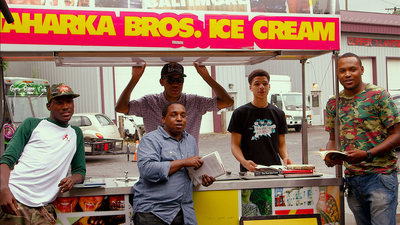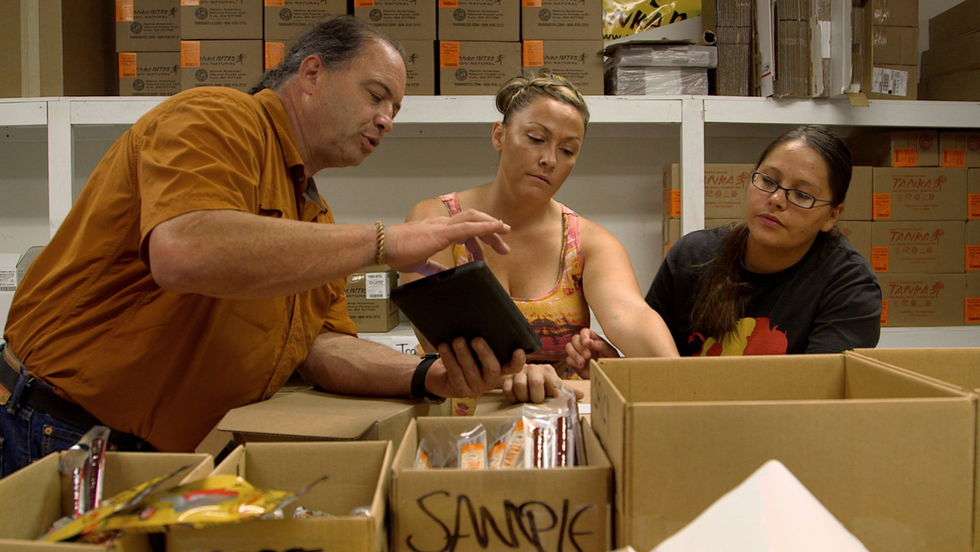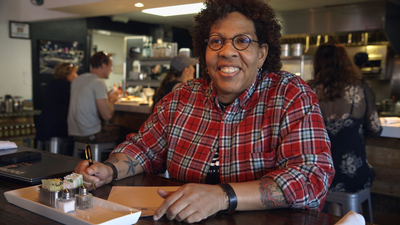
BY MATTHEW ENG |
Interview: BUFFALO RETURNS' Mark Tilsen is Transforming His Native Community, One Health Bar at a Time
Gini Reticker's documentary short BUFFALO RETURNS explores how one Native entrepreneur used a centuries-old buffalo recipe to put a new spin on the health bar and revive his struggling Lakota reservation in the process.

Mark Tilsen is fully aware that a buffalo-cranberry health bar probably isn't the first thing that makes one's mouth water.
At the beginning of Buffalo Returns, the illuminating, beautifully-made documentary short directed by Oscar-nominated filmmaker Gini Reticker (Asylum, Pray the Devil Back to Hell) and co-produced by Tribeca Digital Studios and American Express, Tilsen, the president and co-founder of Native American Natural Foods, and a younger associate set up a testing booth smack dab in the center of Columbus Circle. They begin hawking samples of their Tanka Bar, a 100% natural, dried buffalo-and-cranberry energy bar made from a time-honored recipe that dates back centuries from Tilsen's Lakota ancestors. There's just one problem: no one's biting. Literally.
As Tilsen and his partner eagerly encourage passing crowds of jaded Manhattanites and bemused tourists to try their product, they barely receive a reaction at all. But then something starts to shift, as a young, backpacked man wanders over, enticed by the promise of "meat." And soon, slowly but surely, more people begin coming over and coming around, getting over their initial perplexity and cautiously though curiously partaking in these bite-sized jerky hand-outs. As Tilsen points out, the reactions speak for themselves: "I always watch people’s eyebrows when you say 'buffalo-cranberry' to them because their eyebrows sort of lift up and their eyes squint out. Then if they have enough courage to put it in their mouth, their eyebrows lift up in a different way. And they love it..." It's a sweetly amusing moment that's fully indicative of the product itself, a delicious and culturally-specific curio that is finally getting its due popularity.
Alongside his Natural Foods CEO and fellow co-founder Karlene Hunter, Tilsen has made the Tanka Bar a surprising health food staple, packaging a delectable piece of Native culture and placing it in nearly every Whole Foods in the country. Through their small but lucrative business, Tilsen has been able to transform his home, the Pine Ridge Reservation in Southwestern South Dakota, once an irrecuperably troubled site of poor living conditions and profound socioeconomic tensions, into a place of promise and reinvention through new housing opportunities and wider community initiatives. But it wasn't always smooth sailing for Tilsen, Hunter, and Tanka. Following the Great Recession, the business suffered a steep and near-fatal decline that forced the two co-founders to each put their own livelihoods on the line in order to keep the business afloat. Although they've made it to the other side, Tanka is still, at heart, a community business and one that's prone to occasional financial setbacks and a steady influx of lesser corporate competitors, even as it continues to grow into something bigger, bolder, and better than even its creators might have dreamed.
We spoke to Tilsen about the making of Buffalo Returns, the bright future of the Tanka industry, and how social media has been an invaluable storytelling device in allowing their product to reach the type of widespread audience that neither he nor his community could have ever anticipated.
How did your involvement with American Express begin?
I got a call from Gini Reticker or somebody that worked with Gini, saying that they were writing a proposal about businesses in unusual places. And we talked about different projects on the reservation: our business, Native American Natural Foods, but also Kili Radio [an independent, Lakota-owned FM radio station], Thunder Valley [a non-profit dedicated to strengthening, empowering, and educating Native American youths and the wider Native community], Solar Warriors [a renewable energy program]. I gave them a bunch of ideas of projects we work on and she wrote the proposal.
What was it like having Gini Reticker and a whole filmmaking crew follow you around? Did it take some adjusting to?
Yeah, it took a little time. But it was such a great crew that it was kind of easy to get relaxed with them and show them everything we’re up to… They were a pleasure to work with. They were obviously folks who’ve got a lot of experience and have done a lot of stuff around the world.
How long was the shoot for the film?
Their team came out to the reservation and they were there for probably a week. And they filmed all over the reservation. They filmed employees, they filmed us, they filmed the buffalo, the prairie, and all that. And this is a pretty isolated place. It’s 87 miles from a small airport. So, geographically, in North America, it’s probably as isolated as you can get… And then we went out to Columbus Circle and we did some filming in New York as well, and so that was another day-and-a-half or two days of stuff. And then we re-did a few [voice-overs] too, just little things that [Gini] needed. So our involvement was seven or eight days, maybe a little longer.
 (L-R): Sound Recordist Judy Karp; Tilsen; Field Producer Larry Pourier; Reticker; Cinematographer Kirsten Johnson. Photo: Fork Films.
(L-R): Sound Recordist Judy Karp; Tilsen; Field Producer Larry Pourier; Reticker; Cinematographer Kirsten Johnson. Photo: Fork Films.
I think part of what makes Buffalo Returns so special is that it looks hopefully towards the future while also keeping a really sobering and educational eye on the harrowing past of your Native American ancestors. What do you hope viewers take away from you and your family's story?
Well, I think the reservation is a place of great contradictions, you know? It’s a beautiful place. The land is beautiful. The people are beautiful. The animals are beautiful. It’s got a long, beautiful history to it. A very deep culture. And then it has this sort of ugly side to it that’s full of poverty and disease, oppression and manipulation and political… almost like an economic form of apartheid, you know? It’s got these totally unacceptable living conditions and political structure.
And I think that [Gini’s] team did a really good job of getting most of that out. You know, it’s not just a poverty porn piece, where it’s like, Here’s how bad it is! And, you know, we get a lot of those about the reservation. And you can do that about New York City or anywhere. It’s just that there’s a lot of really bad poverty. And I think that [Gini] did a good job and the team did a good job of balancing, like you said, positive, hope, sharing people’s dreams… but dealing with the real reality of where we're at...
I also like [Gini’s] style, in that, after they said they were going to do this, I watched a couple of her other documentaries. And I liked the fact that she doesn’t ever use narration. The people’s voices are just there. And she lets people tell their own stories. And I know that must be a harder way to produce a documentary because you don’t have this narrator that can tie everything together for you. But I really like the style of it.
BUFFALO RETURNS - Directed by Gini Reticker from Tribeca Film on Vimeo.
What has the national recognition meant not only for your business and community projects, but also for your family?
My son [Nick Tilsen], who’s also in the film as the director of Thunder Valley Community Development Corporation, has, since the film was shot, become an Ashoka Fellow and he’s done a regional TED Talk. He’s become very well-known nationally as an up-and-coming Native leader and innovator of sustainable development. And so I think it probably had a pretty good impact on him.
I think, for the brand, we’re three-times bigger now than when [the film] was shot. Most of that shooting happened in the summer of [2013]. And it says in the film that we’re a $2 million company. We’re a little more than a $5 million company now. I can’t tell immediately what the impact of the film is. I can only go off of what people who have contacted me, who’ve seen it, and lots of friends of mine who I’ve been out of touch with for twenty years or whatever have contacted me because they somehow ran across the film… I think it’s a really credible way of sharing our story cause it’s an independent group looking at what we’re doing. I think that credibility does help a lot. But I couldn’t point to one game-changing event that the film created, at least not yet. But it could.
Buffalo Returns fully acknowledges that we are in a new age of social media and examines how this outgrowth can really be a boon to business owners with big ideas and seemingly impossible dreams. How has that aided in the success of the Tanka industry? Could you imagine your company existing without social media?
Not without the internet, for sure. I mean, we’re in Kyle, South Dakota, so that’s 3,000 some-odd people living there. And we have between 75 and 125,000 people every month that interact with the brand through the web, through social media, through some mechanism. And a little company could never do that and be able to market. We’re in almost every Whole Foods in the country now, all the REIs. Social media gives us — I wouldn’t call it a level playing field, but at least it gives us a field to play on. Without that, we wouldn’t even be able to participate.
I do want to point out that I still believe that President Obama’s initiative for complete internet connection is essential. We operate on the fringes. We have T1s but they’re very inconsistent, they go down a lot. Technologically, the reservation’s connections are way better than they were five years ago, but it’s still a really big problem. The quality of internet connection and total access — in any reservation and in a lot of poor minority communities around the country, it’s still a huge challenge.
What are your future plans for the Tanka bar business, as well as the company's continued efforts at community development within the reservations?
Tanka Bar will be releasing two new flavors in the coming year and a new product line… So our goal is to continue to build a brand and build opportunities, and at the same time, drive the impact of that brand back onto the reservation through efforts of more sustainable development, and by beginning to increase our investment in agriculture, and increase the amount of Natives who are raising buffalo, and increase the economic impact. So, we feel like we’re really just getting started, in terms of being able to have the kind of impact that we’ve always dreamed of. And that’s needed.
Are you still doing those on-the-street sales pitches, like the one we see in Columbus Circle?
Well, we do them at events all the time. We do them at tastings. Like, we’re a featured product at REI’s Labor Day sale, so we’ll have people in probably half of the REIs in the country, giving away product, talking about our brand over the next two weeks during one of their biggest sales of the year. And we do hundreds of those kinds of events… We did that one in Columbus Square because they asked us to do it. They thought it would be kind of a fun way of getting New Yorkers to relate to the film, I think. But we’re not afraid of doing that stuff. We’ve done it before and we’ll do it again. [Laughs]
It’s quite a different world for us in that, you know, seven or eight years ago when we first introduced the Tanka bar, there were no other meat bars in the market. And now there’s a whole host of copycat products that have come. Some are connected to really large corporations. And so it’s creating a whole new category in that when you go to the bars section, you’ll find a meat-and-fruit bars set now, with our bars and a whole bunch of competitors. So, it’s a quite different environment for our little company. It’s kind of the age-old thing of, you know, we’ve created this opportunity, we’ve created this category. We’re the originator of the category and by far the superior product in the category.
But will we be able to stay competitive against an onslaught of candy companies and mystery meat companies who are getting into our industry, who can basically overwhelm us with marketing dollars? Will we be able to stay competitive? That’s our biggest challenge, and that’s really the reason why these type of storytelling methods, like this film and social media and this interview and all this kind of stuff is critically important to us. Because we don’t have enough money to compete. We have to get our story out in other ways.
Buffalo Returns is available via cable on-demand through Comcast, Time Warner Cable, Verizon, Cablevision, Cox and Brighthouse, Vimeo, interactive smart TV app American Express NOW, the American Express YouTube Channel, and American Express OPEN Forum.

